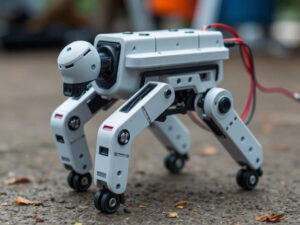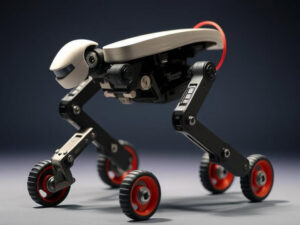Robots are rapidly transforming our world from fantasy to reality. For robots to truly integrate into our world, they must be capable of navigating it effectively. This article explores the fascinating field of robot locomotion mechanisms and how engineers are developing solutions to enable robots to move through complex environments. From drones delivering packages to mobile robots exploring distant planets, the quest for the ultimate mobile robot is driving innovation.
Why Robot Locomotion Isn’t So Simple
Equipping robots with wheels or legs for easy movement is more complex than it seems. Several factors contribute to the challenge of creating effective robot locomotion systems:
- Terrain: A robot designed for a factory floor won’t be suitable for a rocky outdoor terrain. Different terrains demand different locomotion solutions.
- Energy Efficiency: Movement requires energy. Robots need energy-efficient locomotion systems to operate for extended periods.
- Control: Controlling the movement of wheels or legs requires sophisticated control systems. Achieving smooth and balanced movement is a significant challenge.
- Adaptability: Robots must be able to adapt to unpredictable environments and unexpected obstacles. This requires advanced sensors and sophisticated algorithms.
- Cost: Designing high-performance locomotion systems can be expensive. Engineers often need to balance performance with cost considerations.


Robot Locomotion Mechanisms
Numerous robot locomotion mechanisms exist, each with its own advantages and disadvantages:
1. Wheeled Robots
Wheeled robots are the most common type of mobile robot. They are relatively simple to manufacture and highly energy-efficient, making them ideal for use on flat surfaces.
- Advantages: Excellent mobility on flat surfaces, easy to control and reverse, smooth movement.
- Disadvantages: Limited mobility on rough terrain, easily obstructed by obstacles.
- Examples:
- Differential drive robots: Movement is achieved by independently driving two wheels. Commonly used in warehouse robots.
- Ackermann steering robots: Utilise a steering mechanism similar to cars, suitable for large robots and autonomous vehicles.
- Omnidirectional robots: Equipped with wheels that allow movement in any direction, ideal for navigating tight spaces.
2. Legged Robots
Inspired by the movement of humans and animals, legged robots can traverse rough terrain and overcome obstacles that wheeled robots cannot.
- Advantages: Excellent mobility on rough terrain; ability to climb stairs and overcome obstacles.
- Disadvantages: complex to design and control, generally less energy-efficient than wheeled robots.
- Examples:
- Bipedal robots: two-legged robots that mimic human walking. Research focuses on achieving stable walking gaits.
- Quadruped robots: four-legged robots, similar to dogs or horses, offering greater stability.
- Hexapod robots: six-legged robots, like insects, known for their exceptional stability and agility.
3. Aerial Robots
Aerial robots, also known as drones, offer unparalleled mobility by flying.
- Advantages: Ability to access inaccessible areas, bypass ground obstacles, high speed.
- Disadvantages: susceptible to weather conditions, complex control systems, limited carrying capacity.
- Examples:
- Multi-rotor drones: Utilise multiple propellers for lift and control, commonly used in photography and logistics.
- Fixed-wing drones: aircraft-like drones with longer flight times, often used for surveillance and mapping.
4. Underwater Robots
Underwater robots operate in challenging underwater environments.
- Advantages: Ability to explore underwater areas, operate in hazardous environments, and access inaccessible locations.
- Disadvantages: Communication limitations underwater, susceptible to water pressure and currents, challenging to waterproof.
- Examples:
- Remotely Operated Vehicles (ROVs): controlled by a human operator from a surface vessel, used for underwater inspection and maintenance.
- Autonomous Underwater Vehicles (AUVs): computer-controlled and operate autonomously, used for oceanographic research.
5. Hybrid Locomotion Systems
Some robots utilise multiple locomotion mechanisms to achieve greater versatility.
- Walking-Wheeled Robots: Combine wheels and legs for improved mobility on rough terrain.
- Flying-Walking Robots: Integrate flying and walking capabilities for maximum flexibility.
Challenges in Developing Successful Robot Locomotion Mechanisms
Creating successful robot locomotion systems presents several significant challenges:
- Energy Efficiency: Robot movement consumes significant energy. Developing energy-efficient systems is crucial for maximising battery life and operational range.
- Control Systems: Controlling the movement of legged and wheeled robots requires sophisticated control systems to ensure balance, precise movement, and proper navigation.
- Sensor Fusion: Integrating data from various sensors, such as cameras, lidar, and GPS, is essential for enabling robots to perceive their environment and navigate effectively.
- Terrain Adaptability: Robots must be able to adapt to different terrains. This requires developing locomotion systems and algorithms capable of identifying and responding to varying surface conditions.
- Reliability and robustness: Robots are often deployed in harsh environments. Locomotion systems must be robust and reliable to withstand these conditions.
- Miniaturisation: Some applications, such as medical robotics, require miniaturised locomotion systems. Designing these systems while maintaining efficiency is a significant.


Future Developments in Robot Movement
The field of robot locomotion is constantly evolving. Some promising future developments include:
- Bio-inspired Mobility: Drawing inspiration from nature and animal movement to create more efficient and robust locomotion systems.
- Soft Robotics: designing robots from flexible materials that can adapt to complex shapes and spaces.
- Locomotion with AI Control: Utilising artificial intelligence to develop more intelligent and autonomous locomotion systems.
- Modular Robots: Creating robots with modular and reconfigurable locomotion mechanisms that can be adapted to different tasks.
Robot locomotion mechanisms are a critical area of research in robotics. The challenge of developing efficient and versatile locomotion systems holds the key to unlocking the full potential of robots. With ongoing research and development, we can expect to see increasingly sophisticated robot movement capabilities in the near future, transforming industries from manufacturing and logistics to healthcare and space exploration. The robot age has truly begun!









































Leave a Review